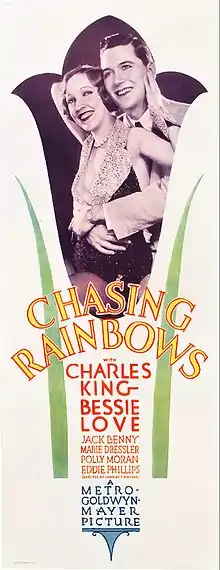Chasing Rainbows (1930 film)
Chasing Rainbows (also known as The Road Show)[3] is a 1930 American Pre-Code romantic musical film directed by Charles Reisner, and released by Metro-Goldwyn-Mayer.
| Chasing Rainbows | |
|---|---|
 Theatrical release poster | |
| Directed by | Charles Reisner |
| Written by | Al Boasberg Wells Root Kenyon Nicholson Charles Reisner |
| Based on | Road Show by Robert E. Hopkins Bess Meredyth |
| Starring | Bessie Love Charles King |
| Music by | Milton Ager Jack Yellen |
| Cinematography | Ira H. Morgan |
| Edited by | George Hively |
| Distributed by | Metro-Goldwyn-Mayer |
Release date |
|
Running time | 106 minutes (complete but lost)[1] 90 minutes (extant) 85 minutes (TCM print) |
| Country | United States |
| Language | English |
| Box office | $700,000[2] (equivalent to $10,700,000 in 2019) |
The film reunites The Broadway Melody stars Bessie Love and Charles King, with a supporting cast of Jack Benny, Marie Dressler, and Polly Moran.[4] This was Jack Benny's first dramatic role in a motion picture.
Filmed in July and August 1929, it was not released for months later, missing an opportunity to capitalize on the success of its song "Happy Days Are Here Again", which by then had already been a major hit.[2]
Plot
Carlie (Love) and Terry (King) are in a traveling vaudeville troupe with Eddie (Benny), the stage manager; Bonnie (Dressler), a comedian; and Polly (Moran), the wardrobe mistress. Terry constantly falls in love with his leading ladies, and marries Daphne (Martan), a two-timing songstress. When he finds her with another man, Terry threatens to kill himself, but Carlie reassures him that "Happy Days Are Here Again," and the show goes on.[1][5]
Cast
- Bessie Love as Carlie Seymour
- Charles King as Terry Fay
- Jack Benny as Eddie Rock
- Marie Dressler as Bonnie
- Polly Moran as Polly
- George K. Arthur as Lester
- Gwen Lee as Peggy
- Nita Martan as Daphne Wayne
- Eddie Phillips as Don Cordova
- Youcca Troubetzkov as Lanning[6]
Reception
The film was commercially successful,[2] but not as much as expected.[7]
Love, Dressler, and Benny all received positive reviews for their performances.[1][5]
Preservation status
Chasing Rainbows was mostly filmed in black and white, but had two Technicolor sequences. The film survives, but those sequences are lost, having been removed for a 1931 re-release and destroyed in the 1965 MGM vault fire. Sound from the lost color sequences still exists on Vitaphone disks, including "Happy Days Are Here Again".[8]
The film has been issued on DVD in the Warner Archive Collection.
References
- "Chasing Rainbows". The Film Daily. 1930. p. 9.
- Bradley, Edwin M. (August 11, 2004). "There's a Tear for Every Smile in Hollywood". The First Hollywood Musicals: A Critical Filmography of 171 Features, 1927 through 1932. McFarland. p. 213. ISBN 978-0-7864-2029-2.
- "New M-G-M Release Schedule". Hollywood Filmograph. June 22, 1929. p. 23.
- Hall, Mordaunt (February 22, 1930). "Movie Review: Chasing Rainbows (1929)". The New York Times. Retrieved September 11, 2014.
- Lusk, Norbert (June 1930). "The Screen in Review". Picture Play. pp. 64–5.
- Dickstein, Martin (February 24, 1930). "The Cinema Circuit". The Brooklyn Daily Eagle. Brooklyn. Retrieved June 6, 2014.
- "W.B. Hollywood Does Top Figure for Current Year". Inside Facts of Stage and Screen. April 5, 1930. p. 3.
- "Chasing Rainbows (1930)". Turner Classic Movies. Retrieved September 14, 2014.
External links
- Chasing Rainbows at IMDb
- Chasing Rainbows at AllMovie
- Chasing Rainbows at the TCM Movie Database
- Chasing Rainbows at the American Film Institute Catalog
- Surviving Vitaphone soundtrack for lost reels 10 & 11 at SoundCloud